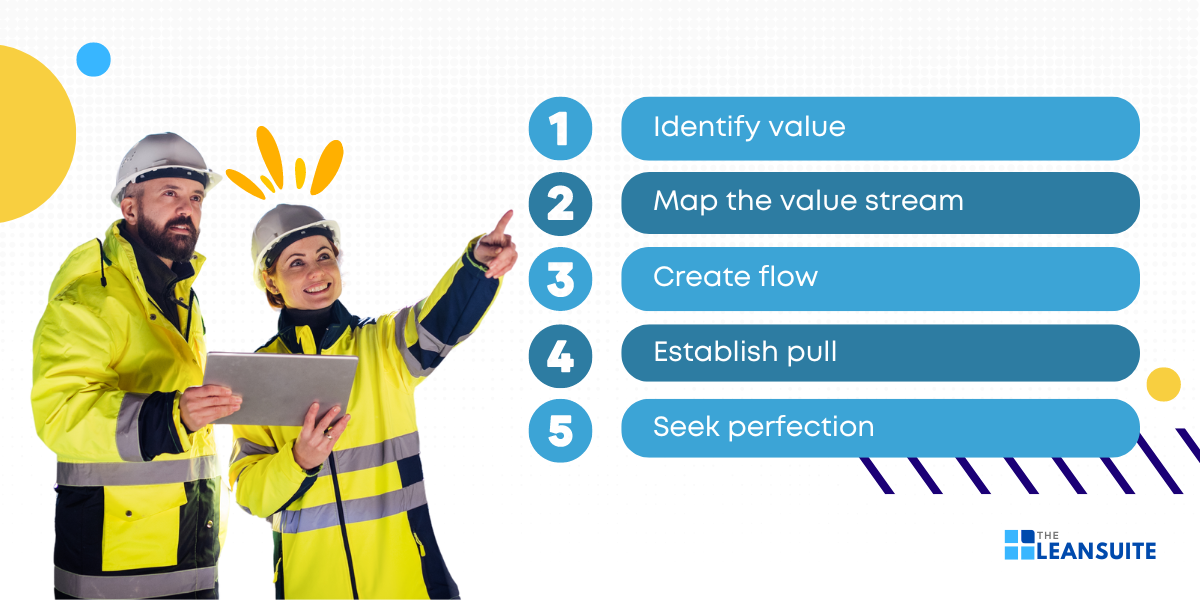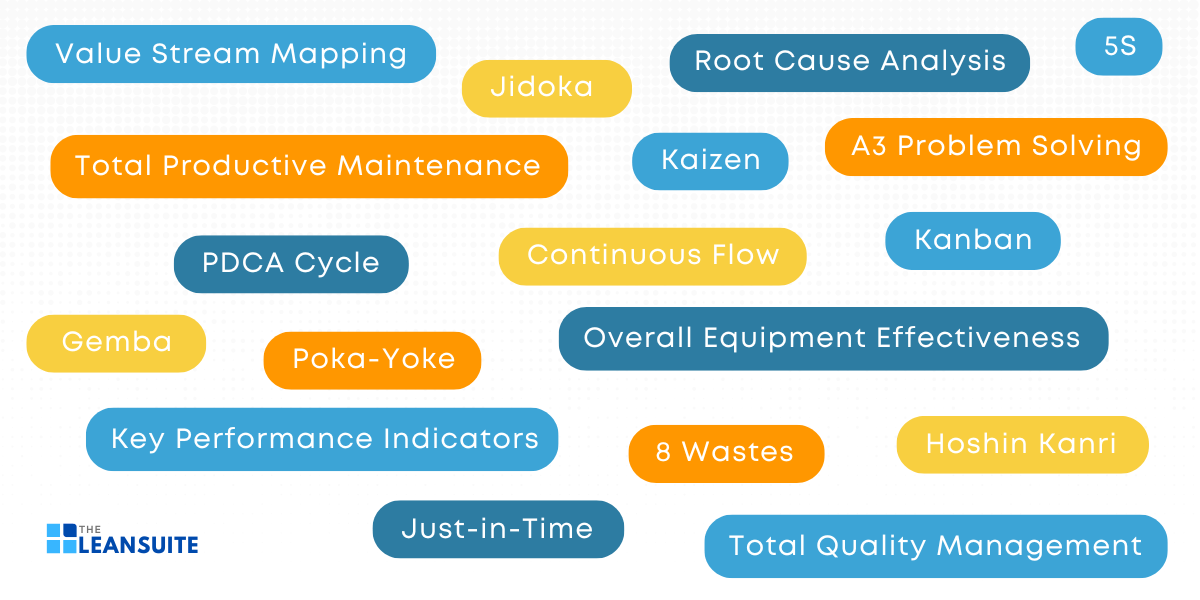Imagine a world where production efficiency reaches its peak, waste is minimized, and every process flows seamlessly—welcome to the world of Lean manufacturing. This methodology has revolutionized the way manufacturers operate. But, what exactly are the tools that make Lean manufacturing so effective? In this blog post, we’ll explore some of the most popular Lean manufacturing tools you need to know.
What is Lean manufacturing?
Lean manufacturing, also known as Lean process management, is a systematic approach to production. Essentially, it aims to minimize waste while simultaneously maximizing productivity. What’s more, it originates from the Toyota Production System and focuses on creating more value for customers with fewer resources.
This approach emphasizes continuous improvement, efficiency, and the elimination of non-value-adding activities, often called “muda” or “waste”. By streamlining workflows and fostering a culture of continuous improvement, Lean manufacturing helps businesses achieve higher productivity, better quality, and increased customer satisfaction.
The five Lean manufacturing principles
Lean manufacturing is built on these five key principles:

1. Identify value
The first principle of Lean manufacturing is to identify what defines value from the perspective of the customer. To clarify, value is defined by the customer’s needs and is what they are willing to pay for. This can be a product, a service, or a feature.
The key here is to understand what the customer values and to ensure that all activities in the manufacturing process contribute to that value. In essence, waste is considered as anything that doesn’t add value.
2. Map the value stream
Once value is identified, the next step is to map the value stream. This involves documenting all the steps and processes involved in taking a product from raw materials to the final delivery to the customer.
Mapping the value stream allows you to visualize the movement of materials and information. Consequently, this helps in pinpointing non-value-adding activities and processes that can be eliminated or improved.
3. Create flow
After mapping the value stream and identifying waste, the next principle is to create flow within the production process. Flow refers to the smooth and uninterrupted movement of products and materials through the various stages of production.
The goal is to ensure that work progresses seamlessly from one stage to the next without delays, bottlenecks, or interruptions. This is because a continuous flow helps to reduce lead times and increases efficiency. Therefore, making it easier to meet customer demands promptly.
4. Establish pull
The fourth principle, establish pull, focuses on producing only what the customer needs when they need it. Instead of pushing products through the production process based on forecasts and schedules, a pull system directly reacts to customer demand.
This approach minimizes overproduction and excess inventory, which are common sources of waste. By aligning production closely with actual demand, you can become more responsive and flexible to changes in customer needs.
5. Seek perfection
The final principle is to seek perfection.
Lean manufacturing is an ongoing journey of continuous improvement. So, you must strive for perfection by constantly assessing and refining your processes. This involves regularly reviewing operations, soliciting feedback, and making incremental changes to enhance efficiency and quality.
The pursuit of perfection encourages a culture of continuous learning and innovation. This, in turn, ensures that you remain competitive and capable of delivering exceptional value to your customers.
The most popular Lean manufacturing tools
As we dive deeper into the world of Lean manufacturing, it’s essential to explore the Lean tools that make this methodology so effective. In this section, we’ll explore the most popular Lean manufacturing tools that have revolutionized businesses worldwide. From streamlining processes to eliminating waste, these tools are crucial for achieving operational excellence. So, let’s take a closer look at how each one can transform your business.

Value stream mapping
Value stream mapping (VSM) is a crucial Lean manufacturing tool that visually represents the flow of materials and information as a product or service makes its way through the value chain. By creating a detailed map, you can identify waste, bottlenecks, and areas for improvement within their processes.
This tool is essential for carrying out the second principle of Lean Manufacturing, which is to map the value stream. By doing so, you can distinguish between value-adding and non-value-adding activities. Thereby, allowing you to streamline operations, reduce lead times, and enhance overall efficiency. Ultimately, leading to higher quality products and increased customer satisfaction.
Kaizen
Kaizen is a Japanese word meaning “change for better” or “continuous improvement,” and it is a fundamental tool in Lean manufacturing.
This philosophy focuses on making small, incremental changes to processes, systems, and practices to enhance efficiency and quality. Moreover, Kaizen encourages all employees, from the factory floor to management, to contribute ideas and suggestions for improvements.
By fostering a culture of continuous improvement and problem-solving, Kaizen aims to minimize waste, streamline operations, and maintain high standards of production. Its bottom-up approach empowers workers and promotes a collaborative environment where even small changes can lead to significant overall enhancements in performance and productivity.
Kanban
https://www.youtube.com/watch?v=vU1Qp3dwnQs
Kanban is a visual workflow management tool that is widely used in Lean methodologies to optimize efficiency and productivity in various processes.
Originating from Japanese manufacturing, particularly within the Toyota Production System, Kanban involves the use of visual signals, often in the form of cards or boards, to represent tasks and their statuses. This approach helps teams visualize their work, identify bottlenecks, and manage the flow of tasks through different stages, from initiation to completion.
By limiting the amount of work in progress and focusing on continuous delivery, Kanban supports a more streamlined and flexible workflow. Ultimately, leading to higher quality outputs and faster delivery times.
Jidoka
Jidoka, often referred to as “automation with a human touch,” is a Lean tool aimed at enhancing quality and efficiency.
Originating from the Toyota Production System, Jidoka empowers workers and machines to detect and address problems in real-time to prevent defective products from continuing down the production line. When an anomaly is detected, the process is immediately halted, allowing for quick diagnosis and resolution. Consequently, this ensures high-quality output and facilitates continuous improvement by identifying root causes of issues.
In sum, by integrating human intelligence with automated systems, Jidoka promotes a culture of quality and responsibility in the manufacturing environment.
Gemba
Gemba is a part of the 5G methodology and is a key concept in Lean manufacturing that originates from the Japanese word meaning “the real place” or “the actual place.” In the context of manufacturing, Gemba refers to the shop floor or the place where value is created.
This concept emphasizes the importance of going to the real place where work happens to observe and understand the processes, identify problems, and find opportunities for improvement. By performing a Gemba walk, managers and team members can gain firsthand insights into the workflow, interact with employees, and gather data to make informed decisions.
To streamline the implementation of this valuable tool, leveraging a virtual Gemba walk app can be highly effective. This modern approach not only saves time and resources, but also allows for more frequent and consistent evaluations. Thereby, fostering continuous improvement and increased collaboration across teams.
Continuous flow
Continuous flow is a Lean tool that emphasizes the seamless and uninterrupted movement of products or materials through the production process. This approach aims to eliminate bottlenecks, reduce waiting times, and minimize waste by ensuring that each step in the manufacturing process is directly connected to the next.
By implementing continuous flow, you can achieve a more efficient and flexible production system, capable of responding quickly to changes in demand and reducing inventory levels. Ultimately, the goal is to create a streamlined operation where products move smoothly from start to finish. Therefore, enhancing overall productivity and quality while reducing costs.
Just-in-Time (JIT)
Just-in-Time (JIT) manufacturing is a production strategy aimed at improving business efficiency by reducing waste and inventory costs. Instead of maintaining large inventories, the core principle of JIT is to produce or order parts and products only as they are needed in the production process or by customers.
This approach requires precise coordination and timing, ensuring that materials and components arrive just in time for their use. By minimizing the amount of stock held, you can reduce storage expenses, decrease waste, and respond more swiftly to market demands. This method, popularized by Toyota, fosters a Lean production environment, promoting continuous improvement and operational excellence.
Total Quality Management (TQM)
Total Quality Management (TQM) is a comprehensive approach that seeks to improve the quality of products and services by incorporating a culture of continuous improvement and customer focus across your organization. As a Lean tool, Total Quality Management emphasizes the elimination of waste, efficient processes, and the engagement of all employees in problem-solving and quality enhancement.
The core principles include customer focused, employee involvement, process oriented thinking, and fact-based decision-making. By integrating these principles, you can enhance productivity, reduce costs, and deliver superior value to customers.
Root Cause Analysis (RCA)
Root Cause Analysis (RCA) is another fundamental tool in the Lean methodology. It is used to identify the underlying reasons for problems or inefficiencies within processes. By focusing on the root cause rather than just addressing the immediate symptoms, Root Cause Analysis helps you implement more effective and sustainable solutions.
This approach typically involves a systematic investigation to uncover the root cause of a problem. So, it often using problem-solving tools like the 5 Whys Analysis or Fishbone Diagram. By thoroughly understanding and addressing these basic causes, you can eliminate waste, enhance productivity, and foster continuous improvement. Thereby, driving long-term success and operational excellence.
A3 Problem Solving
The A3 problem solving tool is widely used in Lean manufacturing to identify and address issues in a structured and efficient manner. It is named after the A3-sized paper (11″ x 17″), on which the problem-solving process is documented, and promotes clarity and concise communication.
This tool involves a systematic approach that includes identifying the problem, analyzing the root cause, proposing countermeasures, implementing solutions, and evaluating results. By encouraging a thorough understanding of the problem and fostering collaboration across teams, the A3 problem solving tool helps you improve processes, enhance quality, and drive continuous improvement.
Key Performance Indicators (KPI)
Key Performance Indicators (KPIs) serve as essential metrics in the Lean methodology. It provides quantifiable measures to gauge the efficiency and effectiveness of various processes within an organization.
As a Lean tool, KPIs enable you to identify areas of waste, streamline operations, and enhance productivity by focusing on specific, actionable goals. By regularly monitoring KPIs, you can make data-driven decisions, fostering continuous improvement and ensuring alignment with strategic objectives.
This proactive approach not only helps in maintaining high standards of quality, but also promotes a culture of accountability and continuous learning among employees.
Overall Equipment Effectiveness (OEE)
Overall Equipment Effectiveness (OEE) is a crucial Lean tool that measures the efficiency and productivity of manufacturing equipment. In essence, it provides a comprehensive assessment by evaluating three key factors: availability, performance, and quality.
Availability gauges the proportion of scheduled time that the equipment is operational, performance assesses whether the equipment is producing at its maximum potential speed, and quality examines the rate of defects in the produced items.
By combining these factors, Overall Equipment Effectiveness helps identify areas for improvement, reduce waste, and optimize production processes.
Poka-Yoke
https://www.youtube.com/watch?v=JTI_-xwIIg8
Poka-Yoke, a Japanese word meaning “mistake-proofing,” is a technique used in manufacturing and other processes to prevent human errors before they can cause defects.
Essentially, the concept involves designing systems, processes, or tools in such a way that it becomes nearly impossible for mistakes to occur. For instance, simple examples include jigs, fixtures, or sensors that alert operators to potential errors or automatically correct them.
By embedding these fail-safes into the workflow, Poka-Yoke minimizes the likelihood of errors, enhances efficiency, and ensures consistency in product quality. Thus, streamlining operations and fostering a proactive mindset toward error prevention and continuous improvement.
8 Wastes
One of the most popular Lean manufacturing tool is the identification and elimination of the “8 Wastes,” which are often remembered using the acronym DOWNTIME. Each letter in DOWNTIME represents a specific type of waste that can hinder efficiency and productivity.
By recognizing and addressing these 8 wastes, you can streamline your operations, reduce costs, and improve overall efficiency. The DOWNTIME acronym serves as a convenient reminder for teams striving to implement Lean principles and continuously seek opportunities for improvement.
What are the 8 wastes?
- D – Defects:
Defects refer to products or components that are not up to quality standards. In other words, it requires rework or scrapping. This waste affects both material costs and labor, while also potentially damaging customer satisfaction. - O – Overproduction:
Overproduction occurs when more products are made than are needed at a given time. So, this can lead to excess inventory, increased storage costs, and wasted resources. Ultimately, tying up capital that could have been used elsewhere. - W – Waiting:
Waiting is any idle time that occurs when resources, such as materials, people, or equipment, are not in use. This can happen due to delays, machine breakdowns, or bottlenecks in the production process. Therefore, leading to lost productivity. - N – Non-utilized Talent:
Non-utilized talent refers to not fully leveraging the skills, knowledge, and creativity of your employees. This waste can result from poor management practices, insufficient training, or a lack of empowerment. As a result, this can lead to missed opportunities for improvement and innovation. - T – Transportation:
Transportation waste involves unnecessary movement of materials or products between processes. This can increase the risk of damage, cause delays, and incur additional costs without adding any value to the final product. - I – Inventory:
Excess inventory is a waste that ties up capital and storage space. Additionally, it can lead to obsolescence, increased handling, and management costs, as well as potential quality issues. - M – Motion:
Motion waste includes unnecessary movements by people. For example, reaching, bending, or walking, that do not add value. These movements can lead to fatigue, injuries, and inefficiencies in the workflow. - E – Excess Processing:
Excess processing involves doing more work or using more materials than necessary to meet customer requirements. For instance, this can include over-engineering, redundant inspections, or adding features that the customer does not need or want.
5S
The 5S methodology is a foundational tool in Lean manufacturing and management. It aims to improve efficiency, organization, and productivity in the workplace.
Originating from Japan, 5S stands for five Japanese words that translate to Sort, Set in Order, Shine, Standardize, and Sustain. Each ‘S’ represents a step in the process:
- Sort (Seiri) – involves removing unnecessary items from the workspace to reduce clutter and improve focus.
- Set in Order (Seiton) – focuses on organizing the remaining items in a logical and efficient manner, ensuring everything has a designated place.
- Shine (Seiso) – requires regular cleaning and maintenance to create a neat and tidy environment, which can also help identify potential issues early.
- Standardize (Seiketsu) – involves establishing standardized procedures and practices to maintain the organization and cleanliness achieved in the previous steps.
- Sustain (Shitsuke) – emphasizes the importance of maintaining and continuously improving the 5S practices through training, audits, and employee involvement.
PDCA Cycle
The PDCA cycle, also known as the Deming Cycle or Plan-Do-Check-Act cycle, is an important Lean tool used for continuous improvement in processes and products. Essentially, it is a systematic and iterative method aimed at problem-solving and achieving higher efficiency.
The cycle consists of four distinct steps:
- Plan: In this initial phase, identify the problem or opportunity for improvement, and develop a detailed plan to achieve the desired outcome. This involves setting objectives, defining success criteria, and outlining the steps necessary to implement the change.
- Do: Execute the plan on a small scale to test its effectiveness. This controlled implementation allows for experimentation without disrupting the entire system. During this phase, it’s important to collect data and document any deviations from the plan to understand their impact.
- Check: Evaluate the results of the test implementation by comparing the actual outcomes against the expected objectives. Analyze the data collected during the “Do” phase to determine whether the change is leading to improvement. This step involves critical assessment and identification of what worked well and what didn’t.
- Act: Based on the findings from the “Check” phase, decide on the next steps. If the change was successful, implement it on a larger scale and standardize the new process. If the results were not as expected, use the insights gained to refine the plan and repeat the cycle. This phase emphasizes adaptation and continuous learning to ensure ongoing improvement.
Hoshin Kanri
Hoshin Kanri, also known as “Policy Deployment” or “Strategy Deployment,” is a systematic and strategic planning process that originated in Japan.
It is designed to align your organization’s functions and activities with its long-term goals and vision. By using a structured approach, Hoshin Kanri ensures that every member of your organization, from top management to front-line employees, is working towards the same objectives.
This method involves setting breakthrough objectives, developing detailed plans to achieve them, and continuously monitoring progress through regular reviews and adjustments. The ultimate goal of Hoshin Kanri is to create a cohesive and focused organization that can adapt to changes and maintain a competitive edge while achieving sustained growth and improvement.
Total Productive Maintenance (TPM)
Total Productive Maintenance (TPM) is a comprehensive approach to equipment maintenance that aims to achieve perfect production by eliminating breakdowns, defects, and accidents.
Originating from Japan, Total Productive Maintenance integrates maintenance into the daily operations of a facility. That is to say, it encourages all employees to take ownership of the equipment they use. Moreover, it emphasizes proactive and preventive maintenance to improve equipment reliability and efficiency. Ultimately, enhancing productivity.
Total Productive Maintenance requires a collaborative approach across all organizational levels, involving everyone from management to shop floor workers. As a result, this fosters a culture centred on continuous improvement and teamwork.
In short, by focusing on optimizing equipment performance, Total Productive Maintenance helps you reduce costs, increase uptime, and improve overall operational effectiveness.
Conclusion
The implementation of popular Lean manufacturing tools like 5S, Kaizen, Kanban, and Value Stream Mapping can significantly enhance an organization’s efficiency, effectiveness, and customer satisfaction. However, it’s important to remember that the journey towards Lean manufacturing is not a one-time effort. Instead, it is a continuous commitment to improvement and a readiness to embrace change.
Whether you are just beginning your Lean transformation or seeking to refine your existing processes, leveraging these tools alongside an advanced Lean software can simplify the journey and ensure sustainable success. What’s more, by fostering a culture of continuous improvement and being open to change, you can truly harness the full potential of Lean manufacturing. Therefore, paving the way for long-term growth and excellence.





